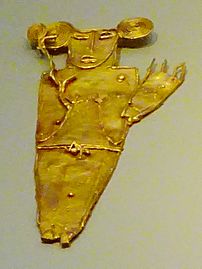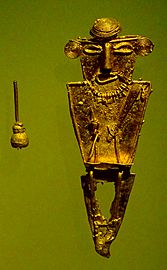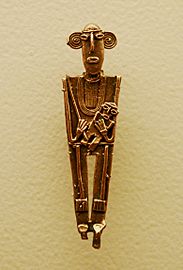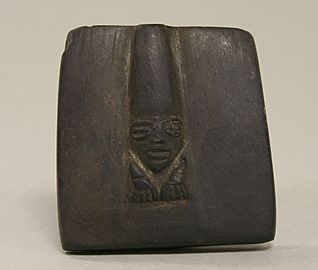Tunjo facts for kids
A tunjo (from the Muisca language: chunso) is a small figure shaped like a person or an animal. These special figures were made by the Muisca people of ancient Colombia. Tunjos were usually crafted from gold or tumbaga, which is a mix of gold, silver, and copper.
The Muisca used their tunjos for important religious reasons. These small offering figures have been found in many places across the Altiplano Cundiboyacense region of Colombia. Tunjos were used as gifts to the gods, to talk with their deities, and when the Muisca asked for special favors. A Muisca historian named Pedro Simón wrote about these interesting tunjos.
Contents
Who Were the Muisca People?
The Muisca people lived in what is now Colombia long before Europeans arrived. They were one of the four most advanced civilizations in the Pre-Columbian Americas. While groups like the Aztecs, Maya peoples, and Inca Empire built huge stone temples and cities, the Muisca lived in simpler homes made of wood and reeds.
The Muisca were especially skilled at working with gold. They traded with other local groups like the Muzo people and Panche people to get gold. From this gold, they made beautiful items such as chest plates, nose rings, earrings, and special containers called poporos. Among all the gold items they made, tunjos are some of the most commonly found.
What Did Tunjos Look Like?
Tunjos were small figures that looked like people, the gods of the Muisca religion, or various animals. They were used in three main ways:
- As decorations placed in the graves of Muisca people, no matter their social class.
- As ornaments at the entrances of temples and holy places. Once these places were full, Muisca priests would secretly bury the tunjos.
- As special offering figures in the Muisca's sacred lakes and rivers.
Many tunjos have been discovered in places like Lake Guatavita and the Bosa River, which is part of the Bogotá River. They have also been found in caves. For example, in 2001, a farmer found three tunjos in Carmen de Carupa. Similar figures have even been found as far south as the Valle del Cauca region of Colombia. Other groups, like the Pijao people, also made tunjos.
How Were Tunjos Made?
The Muisca used clever methods to create their tunjos.
Making Tunjo Figures
One way they made tunjos was by using molds. They would carve molds from soft rocks like shale or obsidian. Then, they would pour melted gold or tumbaga into these molds. Once the metal cooled and hardened, they would remove the stone molds, and the tunjo figure would be ready.
For flatter, two-dimensional tunjos, they used a method called lost-wax casting. Here's how it worked:
- First, they would sculpt the tunjo figure out of beeswax.
- Next, they would cover the wax figure with clay.
- Then, they would heat the clay mold. The heat would melt and evaporate the wax, leaving an empty space inside the clay mold.
- Finally, they would pour the melted gold or tumbaga into this empty space. Once the metal cooled, they would break open the clay mold to reveal the finished tunjo.
Even though many tunjos look like they have thin gold wires attached to them, they were actually cast as a single piece. Scientists have studied the metal and found that these "wires" were part of the original casting process.
What Were Tunjos Made Of?
Scientists have used special tools, like X-ray fluorescence (XRF), to study the metals in tunjos. This helps them understand the exact mix of gold, silver, and copper used. Here are some examples of the metal mixes found in different tunjos:
| Metal | Example 1 | Example 2 | Example 3 | Example 4 | Example 5 | Example 6 | Example 7 | Example 8 | Example 9 | Example 10 |
|---|---|---|---|---|---|---|---|---|---|---|
| Gold | 71.54% | 79.48% | 96.90% | 88.64% | 88.72% | 81.10% | 86.72% | 85.62% | 54.63% | 45.91% |
| Silver | 23.67% | 18.01% | 2.48% | 11.05% | 10.02% | 12.18% | 12.79% | 12.79% | 16.31% | 10.55% |
| Copper | 4.62% | 2.48% | traces | 0.12% | 1.11% | 5.94% | 1.16% | 1.47% | 29.31% | 43.70% |
| Lead | traces | 0.28% | traces | |||||||
| Iron | 0.02% |
Where Can You See Tunjos Today?
While most Muisca artifacts are in museums in Colombia, tunjos are some of the most common Muisca items found in museums around the world. You can see tunjos in collections at places like the American Museum of Natural History, the British Museum, the Metropolitan Museum of Art, and the Smithsonian Institution's National Museum of the American Indian.
Fun Facts About Tunjos
- The largest beer brand in Colombia, Club Colombia, uses a tunjo as part of its logo and symbols.
Gallery
See also
 In Spanish: Tunjo para niños
In Spanish: Tunjo para niños







